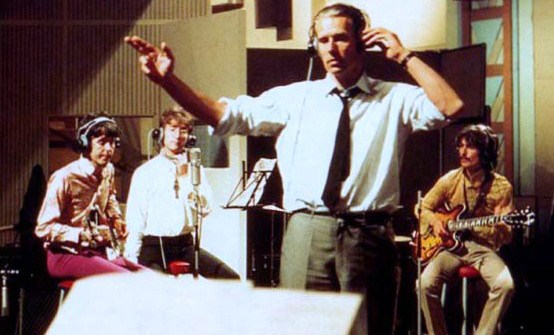Outside of the recording studio, George Martin seemed like an unlikely counterpoint to the jovial and working-class Beatles. Yet the creative partnership between the fab four and Martin forever changed the sound of popular music. Acting behind the scenes, Martin possessed a creative curiosity for recording science which equally matched and continued to evolve alongside the craft of Lennon and McCartney. Despite lasting less than the decade, the pairing of Martin and the Liverpudlian natives casts a long shadow over the world of popular music.
Following the Beatles’ demise, Martin continued as he had done before, working with pop artists to capture what he believed to be their best creative aspects. But, the cruel irony of listening to music at what are now known to be unhealthy volumes led to premature deafness. The recordist slowly slipped closer to semi-retirement throughout the 1980s. Passing away at aged 90 last week, Sir George Martin‘s many achievements will always be best remembered within the world of pop. In commemoration, we look back at some of the recordist’s landmark tracks.
The Beatles, Money (That’s What I Want)
When it came to piano, the Beatles were far from exceptional. For most of their early albums, it was Martin sitting behind the piano rather than any of the fab four. Whether it was scoring classical arrangements for orchestral sections, or laying down some rock’n’roll keys for the cover of this Motown classic, the producer wasn’t afraid to get out from behind the mixing desk and roll up his sleeves.
The Beatles, In My Life
Any songwriter can tell you how a bridge can make or break a hit song. Coming in between 1:28 -1:46, Martin demonstrates his classical prowess with a baroque harpsichord-sounding piano arrangement. Capturing the sweetness and introspection of Lennon’s lyrics, Martin’s brief yet striking contribution showcases a growing creative chemistry with the group. In the modern world of Top 40 pop songs, where a writer or producer can take credit for a single lyric, sample or introduction of a pop song, the track also demonstrates the relative humbleness that belied Martin’s professional values.
The Beatles, Eleanor Rigby
Inspired by the evocative strings of the Psycho film score, Martin suggested that McCartney set his lyrics and melody to a string quartet. While The Beatles had allowed Martin work in some strings on Yesterday, John and Paul were sceptical about the idea. Regardless, Martin somehow got his way and the song went on to be one of pop music’s most unconventional hits.
The Beatles, A Day In The Life
The Sgt. Peppers closer is considered by many to be The Beatles greatest work, and Martin’s fingerprints are all over it. Overseeing the orchestral elements, Martin asserts that the orchestration’s initial crescendo was his idea, purposed to tie together what are effectively two disparate contributions from John and Paul. Considering the whole thing was created using four-track recording, the end result is astounding.
The Beatles, Strawberry Fields
Like I Am the Walrus, this track shows the innovation and painstaking manual labour which Martin was willing to go to in order to realise even the whimsiest of the Beatles’ creative inclinations. Under direction from Lennon to create something ‘less racious,’ Martin worked in some horn and cello arrangements while John sung in a different key and employed a different tempo. In the end, Lennon liked both and requested Martin splice the two tapes into one. Addressing what another producer might considered an impossible task, Martin tackled the issue of the mismatch by adjusting the speed of the two takes. The result is some of the Beatles most abstract material.
The Beatles, It’s All Too Much
First appearing on the opening seconds of The Beatles’ I Feel Fine in 1965, the Beatles early guitar feedback has defined the sounds of generations of artists. From Jimi Hendrix to Nirvana and Nine Inch Nails, just about every band with an electric guitar has toyed around with the effect at some point. While Lennon and Martin both claim credit for first using this shrill unwanted technical noise as a musical convention, it’s likely that some creative collaboration between both led to a practice. Feedback again appears more prominently on Harrison’s acid inspired It’s All Too Much.
Paul McCartney and Wings, Live and Let Die
Post-Beatles Ringo and Paul worked with Martin on their first solo albums, with Martin also assisting with the arrangement of McCartney’s number 1 solo hit Uncle Albert/Admiral Halsey. A true middle-aged Englishman at heart, Martin just couldn’t get enough of James Bond. Having already provided two themes for earlier films, Martin also began work with Paul McCarney for the theme for 1971’s Live and Let Die. Again, the producer provided the definitive the orchestral elements.
Elton John, Candle in The Wind
Martin gradually became less active as his deafness became worse, but one of the producer’s last great musical contributions was the production and string arrangements for Elton John’s 1997 tribute to the deceased Princess Diana. A reworking of Elton’s 1973 original, Candle In The Wind might not be his most unconventional work, but it was the most commercially successful and one which no doubt holds a great resonance for those struck by the tragic accident which took the English princess’s life.

